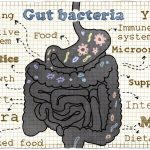Part I
What is gluten and Why all the fuss?
In this article and the following one, I’m going to take on quite a task. I’m going to attempt to break down the momentous amount of research on gluten and health. My goal is to give a brief overview of the current gluten-free movement.
I will be explaining:
- What is gluten?
- Why it caused so much raucous: Celiac disease and beyond?
- Why has sensitivity to this peptide has been controversial?
- How it is now recognized that gluten-sensitivity is a distinct phenomenon, yet viewing gluten as the “food scapegoat” may be too simplistic?
Wish me luck…
“Kneading” Your Way Through Gluten Terminology & All the Raucous
The Terms:
Gluten is a major protein found in wheat, barley, rye, and other related grains. It is thought to be the trigger to the specific immune response to people who have celiac disease. 1-9
Celiac (Coeliac, if your European) disease occurs in genetically susceptible people, often carrying HLA-DQ2 or HLA-DQ8 halotypes (genetic markers found on immune cells). When these individuals are exposed to dietary gluten it leads to small intestinal damage. Celiac disease is considered an autoimmune disease. The classical symptoms are digestive (i.e., diarrhea, abdominal pain, bloating, gas), however; non-specific signs and symptoms (i.e., iron deficiency anemia, osteoporosis, fatigue,) or even asymptomatic presentation are also common.1-2
This autoimmune condition is different from a wheat allergy. The allergy to wheat can cause similar gastrointestinal symptoms, but the response is from an IgE- mediated reaction (a specific antibody response produced by immune cells) to insoluble gliadins in the grain. It causes immediate symptoms but does not cause gut damage.2
A wheat intolerance is related to difficulty in digesting wheat for non-immune mediated reasons. Food intolerances result from genetic variations in enzymes, toxins, chemicals, histamines, salicylates, or food additives.3
Finally, there is Non-coeliac gluten sensitivity (NCGS), which has been an evolving term, mostly by exclusion. Specifically, a condition symptom occurs with gluten ingestion in the absence of celiac disease and wheat allergy. This concept has not gained much acceptance until more recently. 1-2, 4-9
Gluten, It’s Complicated
 However, it’s important to note that gluten itself is a mixture of glutenin and gliadin, and it is the latter of which is considered responsible for disease provocation. 1-9
However, it’s important to note that gluten itself is a mixture of glutenin and gliadin, and it is the latter of which is considered responsible for disease provocation. 1-9
Here’s where it can get complicated…
Several studies have shown that various proteins in gluten can trigger immune responses in celiac sufferers, not just the alpha-gliadin that is the measured “gold standard.” 8-9
Furthermore, there are other components in wheat that could trigger negative responses to the ingestion. These include various lectins, carbohydrate-binding proteins, such as “wheat germ agglutinin” (WGA), that are found in plant foods, grains, legumes, and dairy. Some studies have found evidence that these compounds also trigger inflammatory, immune, or other systemic responses, including intestinal permeability.10-12 (More on that later).
Other grain proteins, termed α-amylase/trypsin inhibitors (ATIs), found in wheat and related grains have also been suggested to trigger immune responses in sensitive individuals.1 Another complication is that cross-reactions to similar protein structures found in gluten of various grains have also been observed to occur in celiac sufferers. This makes some celiac individuals virtually reactive to all grains.13-14
Finally, there’s the fact that wheat is a fructan, a poorly absorbed carbohydrate in wheat. Fructans cause increased water delivery and fermentable substances to the colon resulting in irritable-like symptoms. They are grouped together with similar carbohydrates in the FODMAPs diet: Fermentable Oligo-, Di-, and Mono-saccharides And Polyols.1,15 There has been evidence of removal of these carbohydrates to alleviate many of the symptoms of gluten sensitivity. (This trial used this response to downplay non-celiac gluten sensitivity; however, the flaw of this study’s conclusion on that account was using whey in the control group.)15
It’s also important that the form of the enzyme that breaks down the gluten in the small intestine, tissue transglutaminase (tTG), has several forms and only one, tTG-2 is recognized to cause celiac disease. This “deamination” process of gluten activates immune cells in the gut of celiac patients and produces the inflammation that causes damage to their small intestinal lining.1-9,16-17 However, other types of transglutaminase may cause symptoms in other areas of the body (such as the skin and brain.)16
For some, these additional issues with gluten and its manifestations can cause one on a “gluten-free” diet to still experience symptoms, even after removing “gluten” from their diet.18 For this reason, some doctors may suggest these unfortunates even go “grain-free.”
Why Gluten is a Big- “No-No” for Many
There’s a separate issue with gluten that many are familiar with. Studies have shown that it, along with pathogenic microbes and toxins, causes intestinal permeability in all individuals. Intestinal permeability is known in lay terms as “leaky gut.”It occurs when gliadin causes an upregulation of a protein, zonulin, that regulates intestinal integrity. 19-22
This is important because when this barrier is broken, the gut becomes “leaky” and allows the release of toxins, undigested foods, microbes, and immune activators from the gut to be distributed throughout the whole system. Furthermore, various components in the body’s circulation can also enter the gut, where they don’t belong. You can imagine the havoc this causes in the immune system!
In fact, one study that compared celiac patients with active disease (ACD), celiac patients in remission (RCD), non-celiac patients with gluten sensitivity (GS) and non-celiac controls (NC), it was found that there was an increase in intestinal permeability after gliadin in all four groups. Interestingly, the patients with gluten sensitivity and active celiac disease demonstrated a greater increase in intestinal permeability in those who were in remission from celiac disease and controls. However, those with GS had a stronger response! Furthermore, there was also a higher concentration of the anti-inflammatory signal, IL-10, in the controls versus those with GS and RCD. 19
This is why the body may “over respond” and why intestinal permeability is linked to many autoimmune conditions, beyond celiac disease. It has also been linked to symptoms associated with non-celiac gluten sensitivity, such as IBS (Irritable Bowel Syndrome) and depression.23-27
Due to the fact that health of the gastrointestinal tract is so important for a healthy body, and the link between gluten ingestion and diseases, this is why many practitioners are advocating for many of their patients to go gluten-free.
In the next article, I will discuss more about gluten-sensitivity, the controversy, and why it shouldn’t be a scapegoat for all related conditions.
References:
- Biesiekierski JR, Iven J. Non-coeliac gluten sensitivity: piecing the puzzle together. United European Gastroenterology Journal. 2015;3(2):160-165. doi:10.1177/2050640615578388.
- Louka AS, Sollid LM. HLA in coeliac disease: unravelling the complex genetics of a complex disorder. Tissue Antigens. 2003 Feb;61(2):105-17.
- Nordqvist, C. Food Intolerance: Causes, Symptoms, and Diagnosis. Medical News Today. July 11, 2016. http://www.medicalnewstoday.com/articles/263965.php
- Brown A. Gluten Sensitivity. Problems of an Emerging Condition Separate From Celiac Disease. Expert Rev Gastroenterol Hepatol. 2012;6(1):43-55.
- Catassi C, Elli L, Bonaz B, et al. Diagnosis of Non-Celiac Gluten Sensitivity (NCGS): The Salerno Experts’ Criteria. Nutrients. 2015;7(6):4966-4977. doi:10.3390/nu7064966.
- Biesiekierski JR, Iven J. Non-coeliac gluten sensitivity: piecing the puzzle together. United European Gastroenterology Journal. 2015;3(2):160-165. doi:10.1177/2050640615578388.
- Uhde M, Ajamian M, Caio G, et al. Intestinal cell damage and systemic immune activation in individuals reporting sensitivity to wheat in the absence of coeliac disease. July 25, 2016. doi:10.1136/gutjnl-2016-311964.
- Van de Wal Y, Kooy YM, van Veelen P, et al. Glutenin is involved in the gluten-driven mucosal T cell response. J. Immunol. 1999; 29: 3133–3139. doi:10.1002/(SICI)1521-4141(199910)29:10<3133::AID-IMMU3133>3.0.CO;2-G
- Vader, Willemijn et al. The gluten response in children with celiac disease is directed toward multiple gliadin and glutenin peptides. Gastroenterology. 2002; 122(7): 1729-1737.
- Hashimoto S, Hagino A. Wheat germ agglutinin, concanavalin A, and lens culinalis agglutinin block the inhibitory effect of nerve growth factor on cell-free phosphorylation of Nsp100 in PC12h cells.Cell Struct Funct. 1989 Feb;14(1):87-93.
- Mishkind ML, Palevitz BA, Raikhel NV, Keegstra K. Localization of wheat germ agglutinin–like lectins in various species of the gramineae. 1983 Jun 17;220(4603):1290-2. http://www.ncbi.nlm.nih.gov/pubmed/17769370
- J H Ovelgönne, J F J G Koninkx, A Pusztai, S Bardocz,W Kok,S W B Ewen, H G C J M Hendriks, J E van Dijk. Decreased levels of heat shock proteins in gut epithelial cells after exposure to plant lectins. Gut2000;46:679–687. http://www.ncbi.nlm.nih.gov/pmc/articles/PMC1727920/pdf/v046p00680.pdf.
- Skerritt JH, Devery JM, Penttila IA, et al.Competition ELISA and preabsorption tests indicated that antibody reaction to maize storage proteins did not simply result from cross-reaction of antigliadin antibodies. Clin Chim Acta. 1991 Dec 31;204(1-3):109-22.
- G Kristjánsson, M Högman, P Venge, et al. Gut mucosal granulocyte activation precedes nitric oxide production: studies in coeliac patients challenged with gluten and corn. 2005;54:769-774 doi:10.1136/gut.2004.057174
- Biesiekierski JR, Peters SL, Newnham ED, et al. No effects of gluten in patients with self-reported non-celiac gluten sensitivity after dietary reduction of fermentable, poorly absorbed, short-chain carbohydrates. Gastroenterology. 2013 Aug;145(2):320-8.e1-3. doi: 10.1053/j.gastro.2013.04.051. Epub 2013 May 4.
- Kim SY, Jeitner TM, Steinert PM. Transglutaminases in disease. Neurochem Int. 2002 Jan;40(1):85-103.
- Hadjivassiliou M, Aeschlimann P, Strigun A, et al. Autoantibodies in gluten ataxia recognize a novel neuronal transglutaminase.Ann Neurol. 2008 Sep;64(3):332-43. doi: 10.1002/ana.21450.
- Lebwohl B, Ludvigsson JF, Green PHR. Celiac disease and non-celiac gluten sensitivity. The BMJ. 2015;351:h4347. doi:10.1136/bmj.h4347.
- Hollon J, Leonard Puppa E, Greenwald B, Goldberg E, Guerrerio A, Fasano A. Effect of Gliadin on Permeability of Intestinal Biopsy Explants from Celiac Disease Patients and Patients with Non-Celiac Gluten Sensitivity. Nutrients. 2015;7(3):1565-1576. doi:10.3390/nu7031565.
- Fasano A. Zonulin, regulation of tight junctions, and autoimmune diseases. Annals of the New York Academy of Sciences. 2012;1258(1):25-33. doi:10.1111/j.1749-6632.2012.06538.x.
- Visser J, Rozing J, Sapone A, Lammers K, Fasano A. Tight Junctions, Intestinal Permeability, and Autoimmunity Celiac Disease and Type 1 Diabetes Paradigms. Annals of the New York Academy of Sciences. 2009;1165:195-205. doi:10.1111/j.1749-6632.2009.04037.x.
- Arrieta MC, Bistritz L, Meddings JB. Alterations in intestinal permeability. Gut. 2006;55(10):1512-1520. doi:10.1136/gut.2005.085373.
- Peters SL, Biesiekierski JR, Yelland GW, et al. Randomised clinical trial: gluten may cause depression in subjects with non-coeliac gluten sensitivity – an exploratory clinical study. Aliment Pharmacol Ther. 2014 May;39(10):1104-12. doi: 10.1111/apt.12730. Epub 2014 Apr 1.
- Vojdani A, Kharrazian D, Mukherjee PS. The Prevalence of Antibodies against Wheat and Milk Proteins in Blood Donors and Their Contribution to Neuroimmune Reactivities. Nutrients. 2014;6(1):15-36. doi:10.3390/nu6010015.
- Hamblin, J. This Is Your Brain on Gluten. The Atlantic. Dec 20, 2013. http://www.theatlantic.com/health/archive/2013/12/this-is-your-brain-on-gluten/282550/
- Virgin JJ. Solving the Gluten-Free Debate. Huffington Post. March 26, 2014. http://www.huffingtonpost.com/jj-virgin/gluten-free_b_5022512.html
- Brown A. Gluten Sensitivity. Problems of an Emerging Condition Separate From Celiac Disease. Expert Rev Gastroenterol Hepatol. 2012;6(1):43-55
 Sarah LoBisco, ND, is a graduate of the University of Bridgeport’s College of Naturopathic Medicine (UBCNM). She is licensed in Vermont as a naturopathic doctor and holds a Bachelor of Psychology from State University of New York at Geneseo. Dr. LoBisco is a speaker on integrative health, has several publications, and has earned her certification in functional medicine. Dr. LoBisco currently incorporates her training as a naturopathic doctor and functional medicine practitioner through writing, researching, private practice, and through her independent contracting work for companies regarding supplements, nutraceuticals, essential oils, and medical foods. Dr. LoBisco also enjoys continuing to educate and empower her readers through her blogs and social media. Her recent blog can be found atwww.dr-lobisco.com.
Sarah LoBisco, ND, is a graduate of the University of Bridgeport’s College of Naturopathic Medicine (UBCNM). She is licensed in Vermont as a naturopathic doctor and holds a Bachelor of Psychology from State University of New York at Geneseo. Dr. LoBisco is a speaker on integrative health, has several publications, and has earned her certification in functional medicine. Dr. LoBisco currently incorporates her training as a naturopathic doctor and functional medicine practitioner through writing, researching, private practice, and through her independent contracting work for companies regarding supplements, nutraceuticals, essential oils, and medical foods. Dr. LoBisco also enjoys continuing to educate and empower her readers through her blogs and social media. Her recent blog can be found atwww.dr-lobisco.com.

















